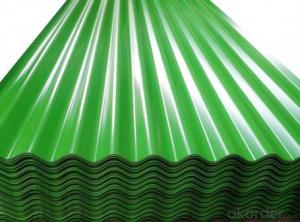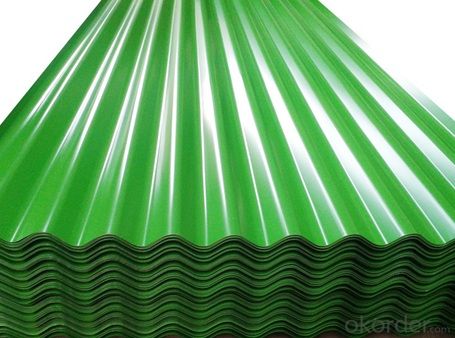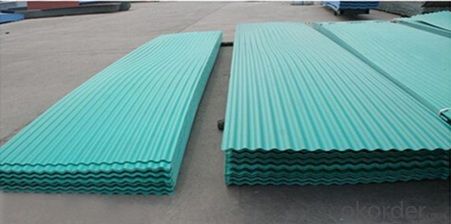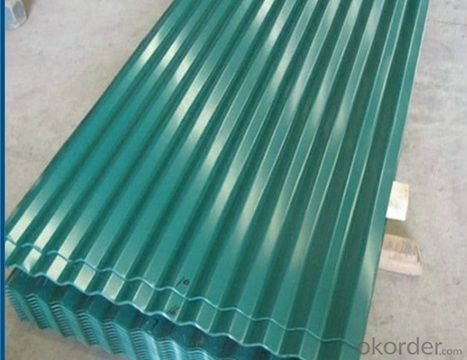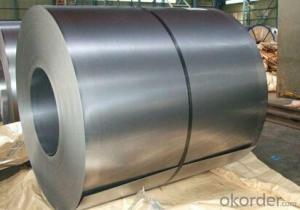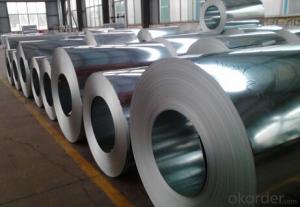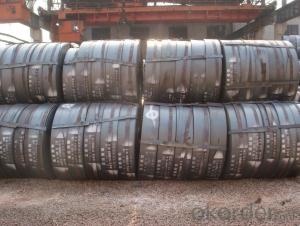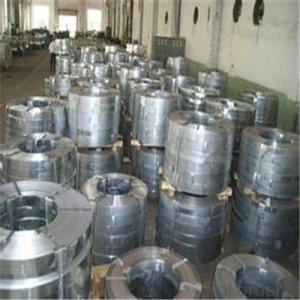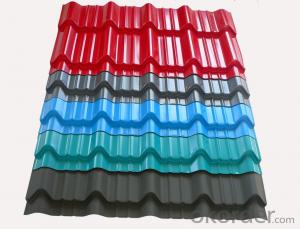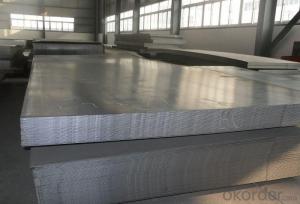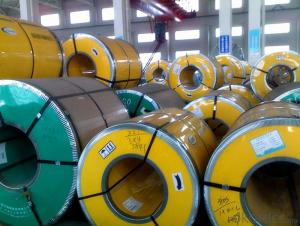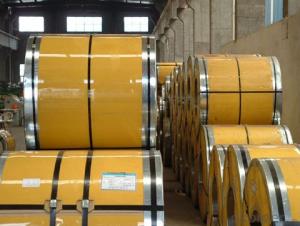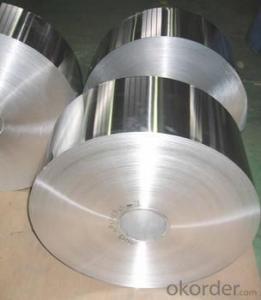Premium Colored Corrugated Roofing Metal Sheet
- Loading Port:
- Tianjin
- Payment Terms:
- TT OR LC
- Min Order Qty:
- 50 m.t.
- Supply Capability:
- 2000 m.t./month
OKorder Service Pledge
OKorder Financial Service
You Might Also Like
Specification
Product Brief Introduction
Premium Colored Corrugated Roofing Metal Sheet
--- Corrosion resistance: Pre-coated steel offers excellent corrosion resistance achived through continuous hot DIP galvanization and corrosion resistant primer/polyester coating. Protection is achieved when zinc and steel are together in the presence of moisture; The zinc protects the steel by galvanic action
Product Features
. Traditional aesthetics outlook
. Suitable for new house or renovation.
. Less joints, watertight
. Long life service
. Tedun also provide relative ridge cap, fasteners and other accessories
Product Specification
Standard:ASTM, GB,JIS,JIS G3302 ASTM 755 EN10169
Grade: DX51D CGCC CS
Thickness: 0.13mm~3.0mm,
Width: 1250,600-1250mm
Coil weight:3-12 MT
Coil ID:508/610mm
Chemical composition:
C | Si | Mn | Cr | Ni | P | S |
0.150 | 0.476 | 11.231 | 12.50 | 0.900 | 0.039 | 0.010
|
FAQ
How long will we receive the goods ?
45days after receiving workable L/C
2. how do you control the quality ?
we have our own quality control department ,we will arrange QC person to see the production line ,when goods finish ,before shipment ,our QC person will check the quality as per our test report request ,if the goods is ok ,then we issue the test report ,and we allow the goods shipping ,otherwise will not allow ship the goods.

- Q: What is the thermal expansion coefficient of a steel strip?
- The thermal expansion coefficient of a steel strip refers to the degree to which the strip expands or contracts when subjected to changes in temperature. The coefficient is a measure of the linear expansion per unit length of the strip for every degree Celsius change in temperature. The specific thermal expansion coefficient of a steel strip can vary depending on the specific type of steel used, as different types of steel have different chemical compositions and crystal structures that affect their thermal expansion properties. However, as a general guideline, the thermal expansion coefficient of most common steel alloys ranges from around 10 to 15 parts per million per degree Celsius (ppm/°C). This means that for every degree Celsius increase in temperature, a steel strip with a thermal expansion coefficient of 10 ppm/°C would expand by approximately 0.001% of its original length. It is important to note that these values are approximate and can vary depending on the specific alloy and other factors.
- Q: What are the different lengths available for steel strips?
- Steel strips come in various lengths to accommodate different applications and requirements. The lengths of these strips can vary from a few inches to several feet, depending on the intended purpose and the industry. Standard sizes for steel strips include 12 inches, 24 inches, 36 inches, and so forth. However, it is also possible to obtain custom lengths by cutting longer strips to the desired size. Furthermore, steel strips can be supplied in rolls or coils, which can have different lengths depending on the thickness and width of the strip. Ultimately, the length of steel strips is determined by factors such as the specific industry, the intended purpose, and the customer's specifications.
- Q: What is the length tolerance of steel strips?
- The length tolerance of steel strips can vary depending on the specific type and grade, but generally it is around ± 0.2% to ± 0.5% of the specified length.
- Q: Are steel strips used in the production of kitchen utensils?
- Yes, steel strips are commonly used in the production of kitchen utensils due to their durability and corrosion resistance.
- Q: What are the challenges in recycling steel strips?
- Recycling steel strips presents several obstacles that need attention. To begin with, a notable hurdle lies in the collection and separation of steel strips from other materials. Steel strips are frequently found in diverse products and can be intermingled with various metals or materials, necessitating their segregation for recycling. This demands the implementation of efficient collection systems and advanced sorting technologies to ensure the exclusive recycling of steel strips and the removal of contaminants. Moreover, steel strips often possess coatings or finishes such as paint, varnish, or galvanized coatings, which complicate the recycling process. The elimination of these coatings is imperative before recycling, as they can taint the recycled steel and compromise its quality. This removal entails supplementary steps that can be time-consuming and costly. Another challenge arises in the transportation and storage of steel strips. Due to their bulkiness and weight, transporting and storing large quantities of steel strips becomes arduous. The effective handling and storage of these steel strips necessitate specialized equipment and appropriate infrastructure, which might not be readily available in all recycling facilities. Furthermore, the recycling process itself can be energy-intensive. Melting down steel strips and reforming them into new products requires a substantial amount of energy. Discovering sustainable and efficient methods to melt and reform steel strips is crucial in reducing the environmental impact of the recycling process. Lastly, the market demand for recycled steel strips can fluctuate, posing challenges for recycling facilities. The availability of cheaper newly produced steel can occasionally impact the demand for recycled steel strips, making it challenging for recycling companies to sell their products and sustain their operations. Overall, while recycling steel strips offers numerous environmental advantages, addressing challenges related to collection, separation, coating removal, transportation, energy consumption, and market demand is crucial for efficient and effective recycling of steel strips.
- Q: What is the surface finish of steel strips?
- The surface finish of steel strips can vary depending on the specific requirements and processing methods used. It can range from a smooth and polished finish to a rough and textured surface. Common surface finishes for steel strips include mill finish, brushed finish, polished finish, and galvanized finish.
- Q: How are steel strips used in the production of roofing materials?
- Due to their durability, strength, and corrosion resistance, steel strips are commonly utilized in the manufacturing of roofing materials. Typically, these strips are crafted from top-notch steel that has been coated with a layer of protective zinc or aluminum to prevent rust and enhance their lifespan. During the manufacturing process, steel strips are frequently rolled into various profiles and shapes, such as standing seam or corrugated sheets. These profiles offer structural stability to the roofing materials, enabling them to withstand harsh weather conditions like heavy rain, snow, and strong winds. Additionally, steel strips serve as a base material for roofing shingles or tiles. In this scenario, the strips are coated with a layer of granulated asphalt or other materials to enhance their aesthetic appearance. This coating not only safeguards the steel from corrosion but also provides extra insulation and weatherproofing properties. Furthermore, steel strips are employed in the production of metal roof panels, which are gaining popularity in both residential and commercial buildings. These panels provide a sleek and contemporary appearance while ensuring exceptional durability and longevity. The steel strips are shaped into panels, which are then affixed to the roof using various fastening methods like screws or clips. In summary, steel strips play a crucial role in the production of roofing materials by offering strength, durability, and resistance to corrosion. They contribute significantly to the overall performance and longevity of roofing systems, safeguarding buildings from the elements while maintaining an attractive appearance.
- Q: What are the different methods for removing coatings from steel strips?
- There are several methods available for removing coatings from steel strips, each with its own advantages and disadvantages. Some common methods include mechanical, chemical, thermal, and abrasive methods. Mechanical methods involve physically scraping or peeling off the coating from the steel strip. This can be done using tools such as scrapers, chisels, or brushes. While this method may be effective for thin or loose coatings, it may not be suitable for thicker or tougher coatings. Chemical methods use chemical agents to dissolve or loosen the coating from the steel strip. These chemicals can be applied through immersion, brushing, or spraying. The choice of chemical will depend on the type of coating being removed. However, care must be taken to ensure that the chemicals used do not damage the steel strip or pose any health risks. Thermal methods involve using heat to burn off or melt the coating from the steel strip. This can be done through methods such as flame or infrared heating. Thermal methods are effective for coatings that can be easily melted or burned, but may not be suitable for coatings that are more resistant to heat. Abrasive methods involve using abrasive materials, such as sandpaper, blasting media, or wire brushes, to physically remove the coating from the steel strip. This method is effective for tougher coatings and can be used to achieve a smooth and clean surface. However, it may be time-consuming and labor-intensive. In some cases, a combination of these methods may be used to remove coatings from steel strips. It is important to consider factors such as the type and thickness of the coating, the condition of the steel strip, and the desired end result when choosing the appropriate method for coating removal. Additionally, safety precautions should always be followed to protect the workers and the environment from any potential hazards associated with the chosen method.
- Q: How are steel strips processed for wear resistance?
- Steel strips are processed for wear resistance through various methods such as heat treatment, coating, or alloying. Heat treatment involves subjecting the steel strips to high temperatures followed by controlled cooling to modify their microstructure and enhance their hardness. Coating techniques like galvanizing or applying a thin layer of ceramic or alloy can provide a protective barrier against wear. Alloying steel with elements like chromium or tungsten can also improve its wear resistance by enhancing its hardness and ability to withstand friction and abrasion.
- Q: What are the different tolerances for steel strips?
- The specific application and industry standards can cause variations in the tolerances for steel strips. The desired level of precision and quality in the final product is typically ensured by specifying tolerances for steel strips. Regarding width tolerance, the manufacturing process and customer requirements determine the range of steel strips. For instance, precision cold-rolled steel strips used in industries like automotive or electronics may have a width tolerance of +/- 0.05mm or even tighter. In contrast, hot-rolled steel strips used in construction or structural applications may have slightly wider tolerances, such as +/- 0.1mm. Thickness tolerance is another crucial aspect, especially for steel strips used in critical applications. The manufacturing method and customer specifications influence the tolerance. Cold-rolled steel strips, known for their high precision, often have tight thickness tolerances ranging from +/- 0.005mm to +/- 0.03mm. On the other hand, hot-rolled steel strips may have slightly looser tolerances, typically ranging from +/- 0.1mm to +/- 0.5mm. Flatness tolerance is also a critical factor, particularly for steel strips used in applications that require a smooth and flat surface. The maximum deviation from a perfectly flat surface is usually specified as the flatness tolerance. For example, cold-rolled steel strips may have a flatness tolerance of a few microns, such as 0.002mm. In comparison, hot-rolled steel strips may have a tolerance of around 0.1mm. Additionally, edge burr tolerance, surface quality, and mechanical properties may also be specified based on the application and customer requirements. It is important to note that these tolerances are general guidelines, and specific tolerances can vary depending on the industry, product requirements, and individual manufacturers' capabilities. Therefore, it is always crucial to consult the relevant standards, specifications, or the steel strip manufacturer for precise information on tolerances for a specific steel strip.
Send your message to us
Premium Colored Corrugated Roofing Metal Sheet
- Loading Port:
- Tianjin
- Payment Terms:
- TT OR LC
- Min Order Qty:
- 50 m.t.
- Supply Capability:
- 2000 m.t./month
OKorder Service Pledge
OKorder Financial Service
Similar products
Hot products
Hot Searches
Related keywords
